New models
Save the Children's Paul Ronalds makes the case for using impact investing to help plug SDG funding gaps
Monday, 06 November 2023

Save the Children's Paul Ronalds makes the case for using impact investing to help plug SDG funding gaps
Monday, 06 November 2023

 Paul Ronalds leads Save the Children Global Ventures, the new in-house team at Save the Children responsible for taking innovative finance and new technologies to scale. He brings a unique mix of private sector, government, and NGO experience to this initiative. Prior to this role, Paul served as a senior advisor to two Australian Prime Ministers; was Deputy CEO of World Vision Australia and, for the last nine years, served as CEO of Save the Children Australia. He led the creation of and is a founding director of Save the Children Australia’s impact investment fund.
Paul Ronalds leads Save the Children Global Ventures, the new in-house team at Save the Children responsible for taking innovative finance and new technologies to scale. He brings a unique mix of private sector, government, and NGO experience to this initiative. Prior to this role, Paul served as a senior advisor to two Australian Prime Ministers; was Deputy CEO of World Vision Australia and, for the last nine years, served as CEO of Save the Children Australia. He led the creation of and is a founding director of Save the Children Australia’s impact investment fund.
The world appears to be on fire: a new chapter of a bitter conflict has erupted in the Middle East; the Russia-Ukraine war shows no sign of abating; and according to the United Nations, we are currently experiencing the highest number of violent conflicts since the Second World War.
These conflicts, together with the climate crisis and the fallout from Covid-19 are reversing decades of improvement in education, health, and equality for millions and tragically stalling progress on the UN’s sustainable development goals (SDGs).
Even before the Covid-19 pandemic, the annual funding gap to meet the SDGs was estimated to be around US$2.5 trillion. Three years on, that has grown to $3.9tr.
With government balance sheets stressed, preventing them from increasing - or in some cases even maintaining - their current level of aid and development spending, we all need to re-think what private investment and philanthropy can do to make our world a better place.
Philanthropy is often under-estimated. A recent report by Citi put the value of global philanthropy (including the value of volunteering) at $US2.3 tr, equivalent to 3 percent of world GDP.
"We all need to re-think what private investment and philanthropy can do to make our world a better place."

Conflict, climate change, and Covid-19 are wiping out development gains. It's time for philanthropy to step up to help plug SDG funding gaps. Photo: Shutterstock.
Yet philanthropy is changing, and some donors are moving away from the traditional approaches to giving. According to the Giving USA 2023 report, total giving decreased in 2022 by 10.5 percent (after adjusting for inflation) – although this came after two years of record donations during the global pandemic.
Last year, the scion of one of the world’s richest families closed its philanthropic activities. André Hoffmann, whose family’s stake in Roche is valued at ($21.65bn), said he was shuttering the Mava Foundation because transferring money long-term due to one feeling guilty doesn’t help and was a ‘senseless strategy’, he said.
A 2022 survey by Fidelity Charitable, meanwhile, found that 62 percent of millennial donors believe that impact investing has greater potential than traditional forms of philanthropy to create long-term positive change.
After two decades in the NGO sector, I have some sympathy for this view. The traditional approach to funding aid and development does not deliver breakthroughs at scale that the world’s most vulnerable people need.
A white paper by the Unlock Aid Group highlighted that only a small group of for-profit contractors and big international NGOs were able to absorb the mega funding grants typically awarded in aid and development. This prevents new players entering the sector, which acts to stymie game-changing innovation and deters the kind of collaboration that would allow the expansive use of scalable, innovative approaches.
The industry’s traditional approaches to funding fails to incentivise results and leads to systemic underinvestment in new technologies that may significantly increase our impact.
Many government and philanthropic grants prioritise compliance over outcomes, and donors’ low tolerance for risk and short-term payment structures are inconsistent with the type of financial model required to nurture the development of new, technology-based business models.

Save the Children's Global Ventures has used impact investment to fund ThinkMD, a social enterprise that has developed smart software to help frontline health workers in Bangladesh improve maternal and child diagnostics. Photo: Shutterstock.
In response to these challenges, Save the Children launched the first impact investment fund run by an aid organisation in Australia and the first child-focused impact investment fund in the world.
With seed funding from STC, insurance giant QBE, and some other philanthropic foundations, in the space of three years, Global Ventures has invested into education, health, and child protection start-ups – all projects closely aligned with Save the Children’s mission and expertise.
One of our early investments was in life-saving social enterprise ThinkMD, a business that has developed smart software that helps frontline community health workers in places like Bangladesh to improve maternal and child health diagnostics.
In fact, peer-reviewed research suggests that when using the technology, less-educated community health workers are between 90-95 percent as effective as US doctors in diagnosing such issues.
We are now in the process of rolling this technology out across more than 50 countries, providing a financial return to ThinkMD, but also making a significant contribution to the third UN sustainable development goal of ensuring healthy lives and promoting wellbeing for all ages.
This first fund was a proof of concept. It raised A$7.42m (US$4.8m) to support enterprises that emphasise social innovation and address pressing social and humanitarian issues.
We are now proud to have launched a second, larger fund to take the idea to scale. We are stepping up our financial target for Fund II, aiming for A$25 million (US$16.3m)
This reflects our belief that to accelerate progress on the most critical issues affecting children, we can’t rely on traditional charity operating models alone.
We must find new ways of intervening that are both more efficient and effective to drive meaningful change, and this requires patient capital that supports creativity and innovation.
Helping children to keep learning, grow up healthy and stay safe, while also working on solutions to address climate change are the key impact areas for this second offering.

Children bear the brunt of poverty and crisis. Smart investing can make a huge difference to millions of lives. Photo: Shutterstock
Of course, we are not alone. A handful of other leading charities and some of the world’s most progressive philanthropic foundations are now adopting similar strategies.
Right now, this investment is a drop in the ocean compared to what is required to tackle the need in our world. Yet, it is an approach that offers new hope.
And at the same time there is a vast untapped source of funding for social investing that could be used for immeasurable good. And it continues to grow each year.
Many countries allow wealthy people to establish private foundations (often called donor-advised funds or DAFs). These funds, which are set up for charitable purposes, provide an immediate tax deduction but allow the donated funds to be dispersed over a longer period.
But are you really maximising your foundation’s social goals if you only allocate 5per cent to a community good and the rest of the funds are invested in stocks and bonds with no connection to mission?
Too many philanthropists and foundations have what corporates would classify as “lazy balance sheets.” Their boards and management teams too often adopt a highly conservative approach to investing their surplus, which contributes very little to the charity’s mission.
This is especially so when investing in social funds such as Save the Children’s Global Venture can, in some cases, offer commercial returns of 10 percent or more.
While traditional philanthropy and government aid have their limits, they still have a critical role to play. It is a false dichotomy to say there should either be philanthropy or market-based interventions like impact investing. We need both.
There are some tasks that philanthropy is uniquely well positioned to do – such as providing emergency humanitarian relief, work in high-risk, fragile settings.
And there is some hope philanthropy will remain strong. It is estimated 2.4 billion people will enter the ranks of the middle class by 2030. There are also projections that women will inherit 70 percent of intergenerational wealth transfers by 2035.
Analysts argue these two trends, plus a post-pandemic reset in charitable donations could spark a philanthropic resurgence as well as curiosity about new vehicles and modalities.
But given the scale of challenges that our world is facing, we will need both philanthropy and social investment at a vast scale if we are to have any hope in delivering on the SDGs.
In October 2023, Paul Ronalds led a workshop Circle's strategic philanthropy for climate change event at NYUAD.
It's a good idea to use a strong password that you're not using elsewhere.
Remember password? Login here
Our content is free but you need to subscribe to unlock full access to our site.
Already subscribed? Login here